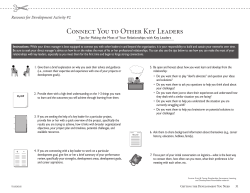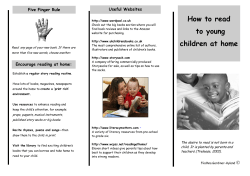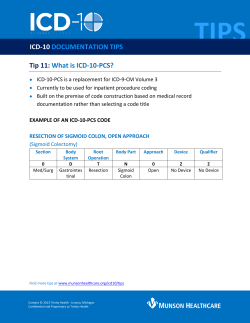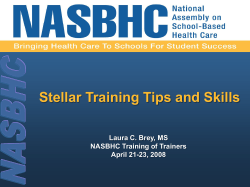
Dr. Pritchard`s Presentation
Giving and Receiving Feedback T. Gail Pritchard, PhD Interim Senior Learning Specialist, Resident and Fellow Development Assistant Professor, Department of Pediatrics 1. 2. 3. 4. Purpose for giving/receiving feedback Tips for giving feedback Tips for receiving feedback Take away Purpose of Giving/Receiving Feedback “Feedback is about providing information to students with the intention of narrowing the gap between actual and desired performance.” (Cantillon & Sargeant, 2008) Giving Feedback • Ramani and Krackov (2012) recommend the following: • “Establish a respectful learning environment. • Communicate goals and objectives for feedback. • Base feedback on direct observation. • Make feedback timely and a regular occurrence” (p. 787). Giving Feedback, cont. • “Begin the session with the learner’s self-assessment. • Reinforce and correct observed behaviors. • Use specific, neutral language to focus on performance. • Confirm the learner’s understanding and facilitate acceptance” (p. 787). Giving Feedback, cont. • “Conclude with an action plan. • Reflect on your feedback skills. • Create staff-development opportunities. • Make feedback part of institutional climate” (p. 787). Giving Feedback Cantillon and Sargeant (2008) offer two additional tips: • “Feedback should be viewed as a normal everyday component of the teacherstudent relationship, so that both sides can expect and manage its effects.” • “Feedback should be limited to one or two items only.” Receiving Feedback from: Ten Tips for Receiving Feedback (Algiraigri 2014) 1. Self-assessment • “Break down the task into different components…” (Algiraigri, 2014, p. 3). Example Open-Ended Question: How did things go with your patient encounter? Typical Overall/Global Response: Good Better Response: I was able to develop a rapport with Mr. Smith. This let me gather a detailed history and helped me know what to look for in the physical exam. I think because I was able to establish a rapport, I got the information we needed and we were able to determine her present symptoms were caused by an interaction between her medication and alcohol consumption. Receiving Feedback, cont. 2. Benefitting from feedback • We all have “blind spots.” Feedback helps us see beyond and to further develop. 3. Connect with instructors • “…the bridge that promotes the learning process and initiates dialog about your performance” (Algiraigri, 2014, p. 2). Receiving Feedback, cont. 4. Ask for feedback • Proactive approach sets feedback as a priority and encourages direct observation. • Ask for specifics; probe for details. 5. Be confident and take positive feedback wisely • Be attentive to details—they are the basis for further growth and the next step. Receiving Feedback, cont. 6. Control your emotions • Mistakes are expected—own them. • Use feedback “as an opportunity for personal growth and development rather than a failure” . 7. Take an action plan • If you are defensive, you are not listening. • Clarify vague issues. • Summarize main concerns to be addressed in action plan. (Algiraigri, 2014, p. 3) The Take Away… from: Cleary and Walter (2010) 1. Feedback occurs regularly. 2. Feedback occurs within a context of explicit objectives/goals/aims. 3. Feedback occurs in a private, quiet, distraction-free setting. 4. Feedback gives information for improvement. 5. Feedback provides the context for creating an action plan. 6. Feedback focuses on the behaviors, both strengths and weaknesses. 7. Learners/evaluators need guidelines for receiving/giving feedback. References A.H. Algiraigri. Ten tips for receiving feedback effectively in clinical practice. Medical Education Online 2014; 19: 25141. P. Cantillon and J. Sargeant. Giving feedback in clinical settings. BMJ 2008; 337: a1961. M.L. Cleary and G. Walter. Giving feedback to learners in clinical and academic settings: Practical considerations. J Contin Educ Nurs 2010; 41(4): 153-154. S. Ramani and S.K. Krackov. Twelve tips for giving feedback effectively in the clinical environment. Medical Teacher 2012; 34: 787-791. Resident and Fellow Development T. Gail Pritchard, PhD AHSC 3210 520-626-2390 tpritcha@email.arizona.edu
© Copyright 2025















